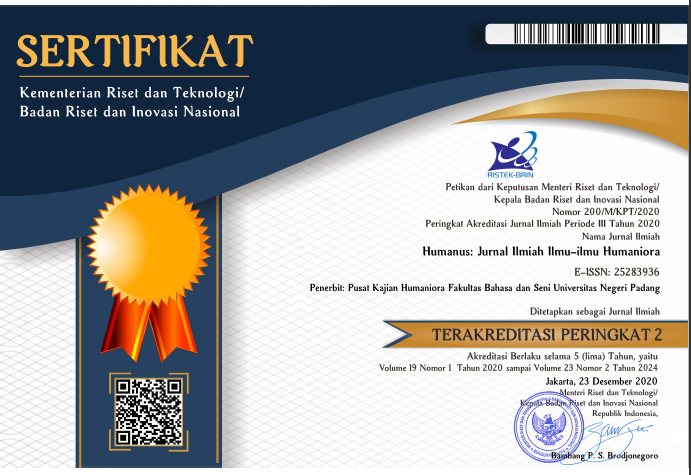Foucault's Docile Bodies Perspective: The Figure of Seniwati's Feminism in the Wido Documentary Film
 ), Sri Kusumo Habsari(2), Deny Tri Ardianto(3),
), Sri Kusumo Habsari(2), Deny Tri Ardianto(3), (1) Sebelas Maret University Surakarta
(2) Sebelas Maret University Surakarta
(3) Sebelas Maret University Surakarta
 Corresponding Author
Corresponding Author
Copyright (c) 2023 Humanus: Jurnal Ilmiah Ilmu-ilmu Humaniora
DOI : https://doi.org/10.24036/humanus.v22i2.121761
Full Text:
 Language : en
Language : en
Abstract
Keywords
References
Adhtiya, Y. (2015). Keluarga di Masyarakat Jawa dalam Perspektif Cultural Studies. Thesis. Semarang: Fakultas Ushuluddin Universitas Islam Negeri Walisongo. Retrieved from http://eprints.walisongo.ac.id/4309/1/104111014.pdf.
Angel, N. (2019). The Exercise of Patriarchal Power and the Women's Negotiation of Power in "The Arabian Nights". K@ta Kita, 7(1), pp. 101–108. https://doi.org/10.9744/katakita.7.1.101-108.
Bartky, S. L. (1997). Foucault, Femininity, and the Modernization of Patriarchal Power. In D. T. Myers (Ed.), Feminist Social Thought: A Reader (pp. 25–45). London: Routledge. Retrieved from https://faculty.uml.edu/kluis/42.101/Barty_FoucaultFeminityand theModernization.pdf.
Bearn, G. C. F. (2017). Careful becomings: Foucault, Deleuze, and Bergson. Human Affairs, 27(4), pp. 400–415. https://doi.org/10.1515/humaff-2017-0033.
Beattie, L. (2020). Educational leadership: Producing docile bodies? A Foucauldian perspective on Higher Education. Higher Education Quarterly, 74(1), pp. 98–110. https://doi.org/10.1111/hequ.12218.
Bella, E. I. (2019). Eksploitasi Tubuh Perempuan: Konstruksi Michel Foucault dalam Iklan Sabun Giv White Mutiara di Televisi. Thesis. Makassar: Universitas Islam Negeri Alauddin. Retrieved from http://repositori.uin-alauddin.ac.id/14594/.
Butler, J. (1988). Performative Acts and Gender Constitution: An Essay in Phenomenology and Feminist Theory. Theatre Journal, 40(4), pp. 519-531. https://doi.org/10.2307/3207893.
Cahill, A. J. (2000). Foucault, Rape, and the Construction of the Feminine Body. Hypatia, 15(1), pp. 43–63. https://doi.org/10.1111/j.1527-2001.2000.tb01079.x.
Dalimoenthe, I. (2021). Sosiologi Gender. Jakarta: Bumi Aksara.
Foucault, M. (1984). Nietzsche, Genealogy, History (P. Rainbow (ed.); pp. 76–100). Harmondsworth: Penguin Books.
Foucault, M. (1991). The Birth of the Prison. In Discipline and Punish. London: Penguin Books.
Habsari, S. K., Primasita, F. A., & Makmum, M. T. A. (2011). Representasi Dominasi Perempuan dalam Rumah Tangga: Analisis Tekstual Terhadap Situasi Komedi (SITKOM) “Suami-Suami Takut Istri.” Humaniora, 23(3), pp. 256–268. https://doi.org/10.22146/jh.1027.
Hardiansyah, H. (2012). Seni Disiplin Tubuh dalam Perspektif Michel Foucault. Jurnal Substantia, 14(1), pp. 63–72. http://dx.doi.org/10.22373/substantia.v14i1.4836.
Hestad, K. A. (2008). Docile Bodies, Reflective Selves: A Foucauldian-Somatic Perspective on Symbolic Interactionism. Oslo: The University of Oslo. Retrieved form http://urn.nb.no/URN:NBN:no-19369.
Maryanti, S., Rahayu, L. M., & Aksa, Y. (2017). Perlawanan Perempuan dalam Novel Sunda Sandekala Karya Godi Suwarna. Jurnal Pesona, 3(2), pp. 174–188. https://doi.org/10. 26638/jp.446.2080.
Mellamphy, D., & Mellamphy, N. B. (2005). In "Descent" Proposal: Pathologies of Embodiment in Nietzsche, Kafka, and Foucault. Foucault Studies, 3, pp. 27–48. https://doi.org/10.22439/fs.v0i3.871.
Montase Film Independen. (2022). Biografi Himawan Pratista. Montase.org. Retrieved from https://montase.org/mt_team/himawan-pratista/.
Montase Film Productions. (2019). Sinopsis & Info Film Wido. Montase Film Independen Yogyakarta. Retrieved from https://montase.org/wido/.
Mufarihah, L. (2019). Representasi Gender dalam Film “Tenggelamnya Kapal Van Der Wijck”. Jurnal Ilmu Komunikasi, 9(1), pp. 16–32. https://doi.org/10.15642/jik.2019.9.1.16-32.
Nisa, A. C., & Nugroho, C. (2019). Representasi Feminisme dalam Film Drama (Analisis Semiotika John Fiske Drama Kores My ID is Gangnam Beauty). Management, 6(2), 5299. Retrieved from https://repository.telkomuniversity.ac.id/pustaka/151359/ representasi-feminisme-dalam-drama-film-analisis-semiotika-john-fiske-drama-korea-my-id-is-gangnam-beauty-.html.
Prastiningrum, D. (2019). Wido. Montase Film Productions. Retrieved from https://www. youtube.com/watch?v=6ZEUeYBjbIg.
Putri, A., & Nurhajati, L. (2020). Representasi Perempuan dalam Kukungan Tradisi Jawa pada film Kartini karya Hanung Bramantyo. ProTVF, 4(1), pp. 42-63. https://doi.org/10.24198/ ptvf.v4i1.24008.
Ririsaci. (2018). Memahami Pengertian Film Dokumenter serta 6 Jenisnya. Ririsaci Studio. Retrieved from https://ririsaci.com/pengertian-film-dokumenter-serta-jenis-jenisnya/.
Santoso, L., Santoso, H., Wisarja, I. K., Pramono, M., Parchiana, N., Sarjuni, Wilujeng, S. R., & Abror, R. H. (2015). Seri Pemikiran Tokoh: Estimologi Kiri (1st ed.). Yogyakarta: Ar-Ruzz Media.
Saptandari, P. (2013). Beberapa Pemikiran tentang Perempuan dalam Tubuh dan Eksistensi. Surabaya: BioKultur, 2(1), pp. 53–71. Retrieved from http://journal.unair.ac.id/BK@bebera pa-pemikiran-tentang-perempuan-dalam-article-6247-media-133-category-8.html/.
Sudarsih. (2011). Seni Tayub dalam Kehidupan Masyarakat: Fungsi Ritual, Sosial dan Politik Seni Tayub dalam Kehidupan Masyarakat Di Desa Ngadiboyo Kecamatan Rejoso Kabupaten Nganjuk. Thesis. Surabaya: Institut Agama Islam Negeri Sunan Ampel. Retrieved from http://digilib.uinsby.ac.id/21842/1/Sudarsih_B05207027.pdf.
Tradisi Kebaya. (2022). Kebaya Goes To UNESCO. Tradisikebaya.Id. Retrieved from https:// tradisikebaya.id/tentang-kami/.
Utami, C. D. (2010). Film Dokumenter sebagai Media Pelestari Tradisi. Acintya: Jurnal Penelitian Seni Budaya, 2(1), pp. 7–13. https://doi.org/10.33153/acy.v2i1.93.
Warisan Budaya Tak Benda: Ketoprak, (2013). Retrieved from https://warisanbudaya.kemdikbud.go.id/?newdetail&detailCatat=3391.
Wijaya, J. A., & Firmanto, A. D. (2021). Representasi Gender Pada Film Tilik Menurut Studi Semiotik Roland Barthes. Interaksi: Jurnal Ilmu Komunikasi, 10(2), pp. 166–176. https://doi.org/10.14710/interaksi.10.2.166-176
 Article Metrics
Article Metrics
 Abstract Views : 713 times
Abstract Views : 713 times
 PDF Downloaded : 142 times
PDF Downloaded : 142 times
Refbacks
- There are currently no refbacks.
Copyright (c) 2023 Humanus: Jurnal Ilmiah Ilmu-ilmu Humaniora

This work is licensed under a Creative Commons Attribution-NonCommercial 4.0 International License.











